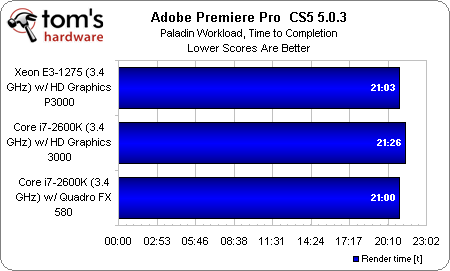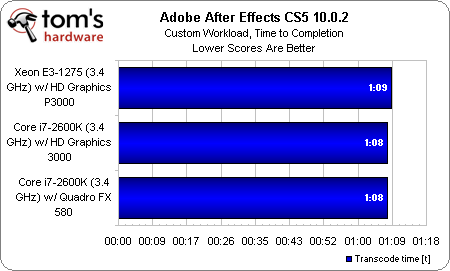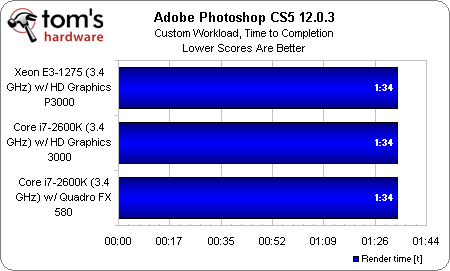Intel Xeon E3-1275 Review: Sandy Bridge Goes Professional
We've already seen Sandy Bridge impress in the desktop space. Does Intel's latest processor architecture have what it takes to dominate the single-socket server and workstation space, too? We run the fastest workstation SKU through our benchmark suite.
Benchmark Results: Adobe CS5 Suite
Our Premiere Pro CS5 test is based on the very processing-heavy Paladin trailer. We already know this project is capable of taking advantage of Nvidia’s CUDA technology. And although it’s possible to manually force CUDA support for cards otherwise not recognized by Premiere Pro CS5 (the Quadro FX 580 isn’t by default), there’s a minimum memory requirement of 750 MB, meaning this 512 MB board can’t help us out.
As a result, all three configurations run in software mode, meaning their respective CPUs—operating at the same frequencies—are on even footing. Though the benchmark does exhibit some variance, we’re confident in calling this one a three-way tie. It’d take a Nvidia card with more memory to make a dent in the render time.
After Effects is similarly processor-limited. The graphics products in our benchmark platforms don’t make a difference in the outcome.
The same holds true for our Photoshop CS5 benchmark, which is optimized to take advantage of threaded processors, but doesn’t benefit from more powerful GPUs.
Fortunately, if your primary reason for buying a workstation is either to work in After Effects or Photoshop, it’s good to know that spending money on a faster graphics card isn’t as helpful as a more powerful CPU or a better storage subsystem.
Get Tom's Hardware's best news and in-depth reviews, straight to your inbox.
Current page: Benchmark Results: Adobe CS5 Suite
Prev Page Benchmark Results: SPECapc And SPECopc Testing Next Page Benchmark Results: Media-
dragonsqrrl one-shotStop teasing and give us a six core Sandy Bridge CPU!Sandy Bridge-E, LGA 2011 X79, Q4 2011.Reply -
agnickolov Finally a compilation benchmark! Now please make it standard in your test suite for CPUs and storage so there's a real benefit from it all for actual comparisons.Reply -
DavC Thanks for this review Chris, very well covered. I'll probably be refering back to this when it comes to spec our next workstations.Reply -
I think this is a useless review. Why are we comparing Apples to Oranges? Lets compare current generation Xeons to Previous generation Xeons.Reply
-
dgingeri one thing I can attest to: companies who cheap out on their workstations and servers never perform well as companies, and eventually fail.Reply
I've worked with many small businesses, and every one that used a desktop chip for a server or a discount chip (Celeron, Duron, etc) for their desktop computers all performed very poorly. Some seemed to hang on by the sheer will of the owner, and in a couple cases, when the owner got sick for more than a week, the businesses folded like lawn chairs.
I've also seen an Engineering shop of ~30 engineers invest nicely into a real server and real workstations, and had me set up their entire network with SBS. their business ramped up so fast and well that they had to hire several more engineers and outgrew SBS (limited to 50 users at the time) within the next 2 years, and I had to go back and rebuild their domain with full enterprise level software, and add another server specifically for email. the owner said the investment in that SBS system was the best thing he'd invested in the business since he hired his first engineer.
Business owners who do not invest in their IT infrastructure fail at business. It's pretty plain and simple. While investing in good IT gear and software doesn't mean you'll ramp up your business to unheard of heights, it does give you a major leg up on the competition. -
given the option of a cheaper Xenon that does not have the P3000 im pretty sure 90% of companies would choose that option, discreet graphics would almost exclusively be employed for the majority of workstation class desktopsReply



